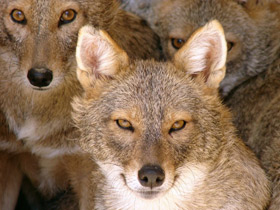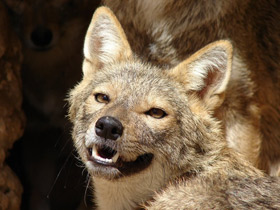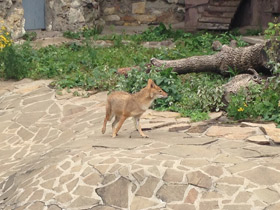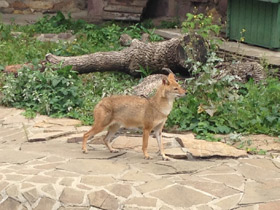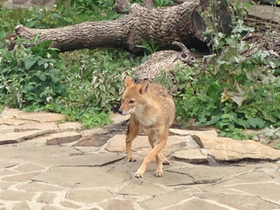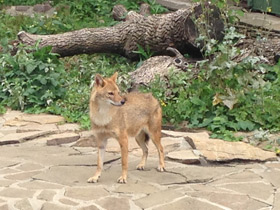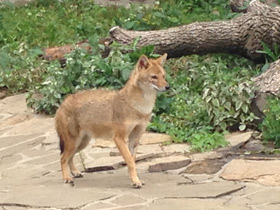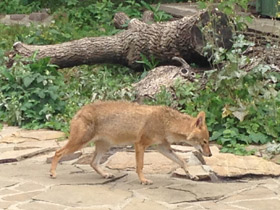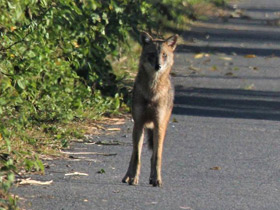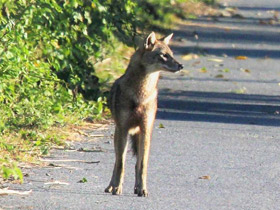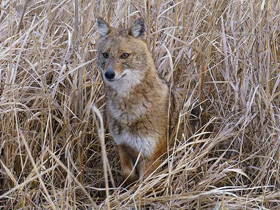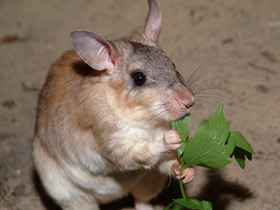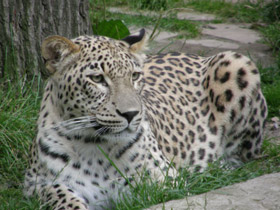The golden jackal or common jackal (Canis aureus)
The golden jackal (Canis aureus), also called common jackal, is a wolf-like canid that is native to Eurasia. The golden jackal's coat varies in color from a pale creamy yellow in summer to a dark tawny beige in winter. It is smaller and has shorter legs, a shorter tail, a more elongated torso, a less-prominent forehead, and a narrower and more pointed muzzle than the Arabian wolf. It is listed as Least Concern on the IUCN Red List due to its widespread distribution and high density in areas with plenty of available food and optimum shelter.
Despite its name, the golden jackal is not closely related to the African black-backed jackal or side-striped jackal, which are part of the genus Lupulella. It is instead closer to wolves and coyotes. The ancestor of the golden jackal is believed to be the extinct Arno river dog that lived in southern Europe 1.9 million years ago. It is described as having been a small, jackal-like canine. Genetic studies indicate that the golden jackal expanded from India around 20,000 years ago, towards the end of the last Last Glacial Maximum. The oldest golden jackal fossil, found at the Ksar Akil rock shelter near Beirut, Lebanon, is 7,600 years old. The oldest golden jackal fossils in Europe were found in Greece and are 7,000 years old. There are six subspecies of the golden jackal. It is capable of producing fertile hybrids with both the gray wolf and the African wolf. Jackal–dog hybrids called Sulimov dogs are in service at the Sheremetyevo Airport near Moscow, where they are deployed by the Russian airline Aeroflot for scent-detection.
The golden jackal is abundant in valleys and beside rivers and their tributaries, canals, lakes, and seashores, but rare in foothills and low mountains. It is a social species, the basic social unit of which consists of a breeding pair and any young offspring. It is very adaptable, with the ability to exploit food ranging from fruit and insects to small ungulates. It attacks domestic fowl and domestic mammals up to the size of domestic water buffalo calves. Its competitors are the red fox, steppe wolf, jungle cat, Caucasian wildcat, the raccoon in the Caucasus and in Central Asia, and the Asiatic wildcat. It is expanding beyond its native grounds in Southeast Europe into Central and Northeast Europe into areas where there are few or no wolves.
Etymology and naming
The word 'jackal' appeared in the English language around 1600. It derives from the Turkish word çakal, which originates from the Persian word šagāl. It is also known as the common jackal.
Taxonomy
The biological family Canidae is composed of the South American canids, the fox-like canids, and the wolf-like canids. All species within the wolf-like canids share a similar morphology and possess 78 chromosomes, allowing them potentially to interbreed. Within the wolf-like canids is the jackal group, which includes the three jackals: the black-backed jackal (Lupulella mesomela), the side-striped jackal (Lupulella adusta), and the golden jackal (Canis aureus). These three species are approximately the same size, possess similar dental and skeletal morphology, and are identified from each other primarily by their coat color. They were once thought to have different distributions across Africa with their ranges overlapping in East Africa (Ethiopia, Kenya, and Tanzania). Although the jackal group has traditionally been considered as homogenous, genetic studies show that jackals are not monophyletic (they do not share a common ancestor), and they are only distantly related. The accuracy of the colloquial name "jackal" to describe all jackals is therefore questionable.
Mitochondrial DNA (mDNA) passes along the maternal line and can date back thousands of years. Thus, phylogenetic analysis of mDNA sequences within a species provides a history of maternal lineages that can be represented as a phylogenetic tree. A 2005 genetic study of the canids found that the gray wolf and dog are the most closely related on this tree. The next most closely related are the coyote (Canis latrans), golden jackal, and Ethiopian wolf (Canis simensis), which have all been shown to hybridize with the dog in the wild. The next closest are the dhole (Cuon alpinus) and African wild dog (Lycaon pictus), which are not members of genus Canis. These are followed by the black-backed and side-striped jackals, members of the genus Lupulella and the most basal members of this clade.
Results from two recent studies of mDNA from golden jackals indicate that the specimens from Africa are genetically closer to the gray wolf than are the specimens from Eurasia. In 2015 a major DNA study of golden jackals concluded that the six Canis aureus subspecies found in Africa should be reclassified under the new species Canis anthus (African wolf), reducing the number of golden jackal subspecies to seven. The phylogenetic tree generated from this study shows the golden jackal diverging from the wolf/coyote lineage 1.9 million years ago and the African wolf diverging 1.3 million years ago. The study found that the golden jackal and the African wolf shared a very similar skull and body morphology and that this had confused taxonomists into regarding these as one species. The study proposes that the very similar skull and body morphology is due to both species having originated from a larger common ancestor.
Appearance
Canis aureus is a species of carnivorous mammal of the family Canidae.
Canis aureus is a small animal, about the size of an average dog: it is about 80 cm long and no more than 50 cm tall at the shoulders, and weighs between 7 and 10 kg.
Canis aureus is slimmer and lighter than the wolf, with relatively taller legs and a sharper, but blunter muzzle than the fox. Its tail is furry and appears very thick; it is always downward slanting, as in the wolf. The wool on the body of Canis aureus is short, stiff and coarse. It has 5 toes on each foreleg and 4 on each hind leg, and its claws are blunt.
The general colour of Canis aureus is grey with a touch of yellow, red or pale. It turns black on the back and flanks and light yellow on the belly and throat. However, the colouring of Canis aureus is very variable and depends on the habitat. The summer coat of this predator is shorter and coarser than the winter coat, and is more reddish in colour, with less black mixed in.
Habitat
Canis aureus is distributed throughout India and regions west of India, in the Near and Middle East, Middle Asia and Asia Minor; throughout Africa north of the Sahara. In Europe it occurs in Greece and the Balkans, the Caucasus, Dagestan and most of the Black Sea coast. At the end of the 20th century. - early 21st century. Canis aureus has entered Ukraine and has appeared in the Ukrainian regions of Donetsk, Odessa and Kherson.
Throughout the area, Canis aureus prefers places with a lot of vegetation and reed thickets near reservoirs. In the mountains it reaches altitudes of up to 2500 m, but is generally less common in the foothills. For shelter, Canis aureus often uses various natural niches and hollows, crevices between rocks, sometimes burrows of badgers, porcupines and foxes; occasionally it digs them itself. There are often well-marked paths leading to their dens.
Canis aureus not only does not avoid human proximity, but often takes up residence near dwellings and trades in leftovers, occasionally steals poultry and enters fields. In India and Pakistan, it is often seen roaming the streets of villages and even cities at night. Even in the vast Delhi of 10 million people, Canis aureus is a frequent resident of overgrown wastelands, graveyards, garbage-strewn urban forests and railway exclusion zones. With such ecological plasticity, the common Canis aureus as a species is, of course, out of danger.
Nutrition and peculiarities
Canis aureus is an almost omnivorous animal. It feeds mainly during the hours of darkness. Scavengers play an important role in its diet. It feeds on a wide range of small animals and birds, as well as lizards, snakes, frogs, molluscs and insects (including beetles and grasshoppers).
Canis aureus like to roam around ponds where they find dead fish. During harsh winters, when ponds freeze over, Canis aureus prefer to hunt wintering waterfowl. After finding the carcass of a large fallen animal, Canis aureus often gather in groups and eat the carcasses together with vultures.
Canis aureus most often hunt alone or in pairs, occasionally in small groups. They sneak up on their prey and capture it immediately. When hunting in pairs, they chase their prey from one to the other.
Canis aureus is a highly evolved animal, not only intelligent and cunning, but also very agile and fast. In a high leap, it can catch a bird that has already risen into the air. Canis aureus seeks its prey at a fine trot, stopping frequently to sniff and listen. When large predators are present, Canis aureus follow them to seize the remains of their prey, snatching the scraps from under their noses.
Canis aureus are sedentary and do not migrate seasonally, but they sometimes stray from their usual range in search of prey and appear in areas where livestock or wild ungulates have been killed to feed on carrion. Canis aureus also eats many fruits and berries, such as grapes, watermelons, melons, bulbous plants and wild sugar cane roots. In Tajikistan, in autumn and winter, it feeds mainly on the fruits of the oleaster tree. Animals living near humans feed largely on rubbish. They scavenge in rubbish dumps and rubbish heaps, and rummage through poor huts in search of edible morsels.
Canis aureus is very noisy and vocal. Before going out to hunt, it emits a loud howl, like a high-pitched, plaintive squeal, which is immediately picked up by others in the vicinity.
Reproduction
Canis aureus mate for life, with the male taking an active part in digging and rearing the young. Pregnancy lasts between 60 and 63 days. From the end of March to the end of May, 4 to 6 (rarely up to 8) pups are born. Female pups are usually born in a burrow, which is a simple corridor up to two metres long and one metre deep. Canis aureus hides in these burrows during the day and at other times of danger.
The female feeds her cubs on milk for 2-3 months, but at 2-3 weeks of age, she begins to feed them by regurgitating swallowed prey. In autumn, the young become independent and hunt alone or in groups of 2 to 4 individuals. Females reach sexual maturity after about one year and males after two years. Canis aureus has a lifespan of 12 to 14 years.
Subspecies
The following subspecies are recognised:
Persian jackal (Canis aureus aureus) - Large, with soft, pale fur with predominantly sandy tones. The general color of the outer fur is usually black and white, while the underfur varies from pale brown to pale slate-grey. Occasionally, the nape and shoulders are of a buff color. The ears and front legs are buff, sometimes tan, while the feet are pale. The hind legs are more deeply tinted above the hocks. The chin and forethroat are usually whitish. Weight varies geographically, ranging around 8–10 kg (18–22 lb). In areas where it borders the range of the larger, more richly colored Indian jackal (particularly the area of Kumaun in India), animals of intermediate size and color sometimes appear. Middle East, Iran, Turkmenistan, Afghanistan, Pakistan and Western India where its distribution overlaps with the Indian jackal to the north and the Sri Lankan/South Indian jackal to the south.
Indochinese jackal (Canis aureus cruesemanni) - The Indochinese jackal (also known as the Siamese jackal and the Southeast Asian golden jackal) has been disputed as a separate subspecies by some authors who state that its classification is based solely on observations of captive animals. In 2023, an mDNA study indicated that it was an early branching lineage of golden jackal which supports it being a subspecies. It is smaller than Canis aureus indicus, weighing up to 8 kg (18 lb). Its fur closely resembles that of a dog. It inhabits mountainous areas, near farms or residential forests, and its prey include small animals like birds, reptiles and frogs, besides occasionally eating fruits. One seller of two trapped jackals claimed that they killed ten piglets on his farm. It can be active in both day and night. Siamese jackals are solitary creatures, but a male and female will cooperate during mating season. It has few natural predators, though dholes are a major source of mortality. Thailand.
Panonia jackal (Canis aureus ecsedensis).
Indian jackal (Canis aureus indicus) - Its fur is a mixture of black and white, with buff on the shoulders, ears and legs. The buff color is more pronounced in specimens from high altitudes. Black hairs predominate on the middle of the back and tail. The belly, chest and the sides of the legs are creamy white, while the face and lower flanks are grizzled with gray fur. Adults grow to a length of 100 cm (39 in), 35–45 cm (14–18 in) in height and 8–11 kg (18–24 lb) in weight. India, Nepal, Bangladesh, Bhutan.
European jackal (Canis aureus moreoticus) - The largest golden jackal subspecies, animals of both sexes average 120–125 cm (47–49 in) in total length and 10–15 kg (22–33 lb) in body weight. The fur is coarse, and is generally brightly colored with blackish tones on the back. The thighs, upper legs, ears and forehead are bright-reddish chestnut. Southeastern Europe, Moldova, Asia Minor and the Caucasus.
Sri Lankan jackal (Canis aureus naria) - Measures 67–74 cm (26–29 in) in length and weighs 5–8.6 kg (11–19 lb). The winter coat is shorter, smoother and not as shaggy as that of indicus. The coat is also darker on the back, being black and speckled with white. The underside is more pigmented on the chin, hind throat, chest and forebelly, while the limbs are rusty ochreous or a rich tan. Molting occurs earlier in the season than with indicus, and the pelt generally does not lighten in color. Coastal South West India, Sri Lanka.
Syrian jackal (Canis aureus syriacus) - Distinguished by its brown ears. The body fur is a yellow on the back, lighter on the sides, and whitish-yellow underneath. A dark band runs from the nose to the end of the tail. Measures 60–90 cm (24–35 in) in body length, 20–30 cm (7.9–11.8 in) in tail length, 15–18 cm (5.9–7.1 in) in head length, and weighs 5–12 kg (11–26 lb). Israel, Syria, Lebanon, and Jordan.
Foraging
The golden jackal often hunts alone, and sometimes in pairs, but rarely hunts in a pack. When hunting alone, it trots around an area and occasionally stops to sniff and listen. Once prey is located, the jackal conceals itself, quickly approaches its prey and then pounces on it. Single jackals hunt rodents, hares, and birds. They hunt rodents in grass by locating them with their hearing before leaping into the air and pouncing on them. In India, they can dig Indian gerbils out from their burrows, and they can hunt young, old, and infirm ungulates up to 4–5 times their body weight. Jackals search for hiding blackbuck calves throughout the day during the calving period. The peak times for their searches are the early morning and the late evening. When hunting in pairs or packs, jackals run parallel to their prey and overtake it in unison. When hunting aquatic rodents or birds, they will run along both sides of narrow rivers or streams and drive their prey from one jackal to another.
Pack-hunting of langurs is recorded in India. Packs of between 5 and 18 jackals scavenging on the carcasses of large ungulates is recorded in India and Israel. Packs of 8–12 jackals consisting of more than one family have been observed in the summer periods in Transcaucasia. In India, the Montagu's harrier and the Pallid harrier roost in their hundreds in grasslands during their winter migration. Jackals stalk close to these roosting harriers and then rush at them, attempting to catch one before the harriers can take off or gain sufficient height to escape.
In Southeastern Asia, golden jackals have been known to hunt alongside dhole packs. They have been observed in the Blackbuck National Park, Velavadar, India, following Indian wolves (Canis lupus pallipes) when these are on a hunt, and they will scavenge off wolf kills without any hostility shown from the wolves. In India, lone jackals expelled from their pack have been known to form commensal relationships with tigers. These solitary jackals, known as kol-bahl, will associate themselves with a particular tiger, trailing it at a safe distance to feed on the big cat's kills. A kol-bahl will even alert a tiger to prey with a loud "pheal". Tigers have been known to tolerate these jackals, with one report describing how a jackal confidently walked in and out between three tigers walking together. Golden jackals and wild boar can occupy the same territory.









